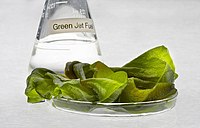
Photo from wikipedia
Background The oleaginous microorganism Schizochytrium sp. is widely used in scientific research and commercial lipid production processes. However, low glucose-to-lipid conversion rate (GLCR) and low lipid productivity of Schizochytrium sp.… Click to show full abstract
Background The oleaginous microorganism Schizochytrium sp. is widely used in scientific research and commercial lipid production processes. However, low glucose-to-lipid conversion rate (GLCR) and low lipid productivity of Schizochytrium sp. restrict the feasibility of its use. Results Orlistat is a lipase inhibitor, which avoids triacylglycerols (TAGs) from hydrolysis by lipase. TAGs are the main storage forms of fatty acids in Schizochytrium sp. In this study, the usage of orlistat increased the GLCR by 21.88% in the middle stage of fermentation. Whereas the productivity of lipid increased 1.34 times reaching 0.73 g/L/h, the saturated fatty acid and polyunsaturated fatty acid yield increased from 21.2 and 39.1 to 34.9 and 48.5 g/L, respectively, indicating the advantages of using a lipase inhibitor in microbial lipids fermentation. Similarly, the system was also successful in Thraustochytrid Aurantiochytrium . The metabolic regulatory mechanisms stimulated by orlistat in Schizochytrium sp. were further investigated using transcriptomics and metabolomics. The results showed that orlistat redistributed carbon allocation and enhanced the energy supply when inhibiting the TAGs’ degradation pathway. Therefore, lipase in Schizochytrium sp. prefers to hydrolyze saturated fatty acid TAGs into the β-oxidation pathway. Conclusions This study provides a simple and effective approach to improve lipid production, and makes us understand the mechanism of lipid accumulation and decomposition in Schizochytrium sp., offering new guidance for the exploitation of oleaginous microorganisms.
Journal Title: Biotechnology for Biofuels
Year Published: 2021
Link to full text (if available)
Share on Social Media: Sign Up to like & get
recommendations!